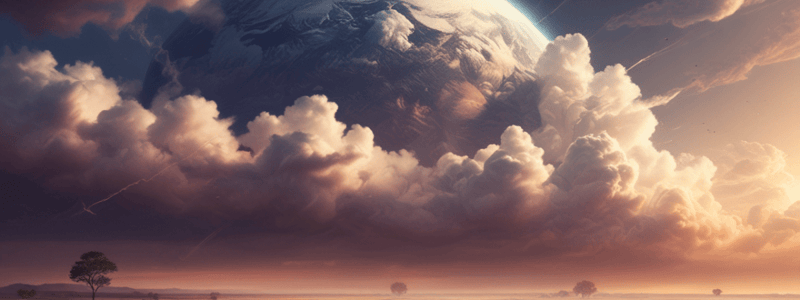Podcast
Questions and Answers
The sky is made up of 90% oxygen and 10% nitrogen.
The sky is made up of 90% oxygen and 10% nitrogen.
False (B)
The troposphere is the layer where aurorae occur.
The troposphere is the layer where aurorae occur.
False (B)
The sky appears blue due to the reflection of light by atmospheric particles.
The sky appears blue due to the reflection of light by atmospheric particles.
True (A)
Clouds are formed by the burning of meteoroids in the atmosphere.
Clouds are formed by the burning of meteoroids in the atmosphere.
Signup and view all the answers
The exosphere is the layer where weather occurs.
The exosphere is the layer where weather occurs.
Signup and view all the answers
Rainbows are formed by the scattering of sunlight by atmospheric gases.
Rainbows are formed by the scattering of sunlight by atmospheric gases.
Signup and view all the answers
Study Notes
Composition
- The sky is made up of different layers of gases, including:
- Nitrogen (78%)
- Oxygen (21%)
- Argon (1%)
- Carbon dioxide (0.03%)
- Water vapor (variable)
- Other gases (trace amounts)
Atmospheric Layers
- The sky is divided into several atmospheric layers, including:
- Troposphere: extends up to 12 km, where weather occurs
- Stratosphere: extends from 12 km to 50 km, where ozone layer is located
- Mesosphere: extends from 50 km to 80 km, where meteors burn up
- Thermosphere: extends from 80 km to 600 km, where aurorae occur
- Exosphere: extends from 600 km to outer space, where atmospheric gases escape
Colors and Light
- The sky appears blue due to:
- Scattering of sunlight by atmospheric gases (Rayleigh scattering)
- Reflection of light by atmospheric particles (Mie scattering)
- During sunrise and sunset, the sky appears:
- Reddish due to scattering of longer wavelengths of light
- Orange and yellow due to scattering of intermediate wavelengths
Phenomena
- The sky is home to various natural phenomena, including:
- Clouds: formed by condensation of water vapor
- Rainbows: formed by refraction and dispersion of light through water droplets
- Halos: formed by refraction of light through ice crystals
- Aurorae: formed by interaction of solar winds with atmospheric gases
- Meteor showers: formed by burning of meteoroids in the atmosphere
Composition
- The atmosphere is composed of 78% nitrogen, 21% oxygen, and 1% argon, with trace amounts of other gases.
- Carbon dioxide makes up a small percentage of the atmosphere, at approximately 0.03%.
- Water vapor is present in varying amounts, depending on atmospheric conditions.
Atmospheric Layers
- The troposphere is the lowest layer of the atmosphere, extending up to 12 km, where weather occurs.
- The stratosphere extends from 12 km to 50 km, and is home to the ozone layer.
- The mesosphere extends from 50 km to 80 km, and is where meteors burn up upon entry.
- The thermosphere extends from 80 km to 600 km, and is where aurorae occur.
- The exosphere is the outermost layer, extending from 600 km to outer space, where atmospheric gases escape.
Colors and Light
- The sky appears blue due to the scattering of sunlight by atmospheric gases, a process known as Rayleigh scattering.
- Mie scattering, or the reflection of light by atmospheric particles, also contributes to the blue color of the sky.
- During sunrise and sunset, the sky appears reddish due to the scattering of longer wavelengths of light.
- The scattering of intermediate wavelengths of light produces orange and yellow hues during these times.
Phenomena
- Clouds form when water vapor condenses in the atmosphere.
- Rainbows are created by the refraction and dispersion of light through water droplets.
- Halos are formed by the refraction of light through ice crystals.
- Aurorae occur when solar winds interact with atmospheric gases.
- Meteor showers occur when meteoroids burn up in the atmosphere, producing bright streaks of light.
Studying That Suits You
Use AI to generate personalized quizzes and flashcards to suit your learning preferences.
Description
Learn about the different gases that make up the Earth's atmosphere and the various layers that it's divided into, including the troposphere, stratosphere, and mesosphere.



